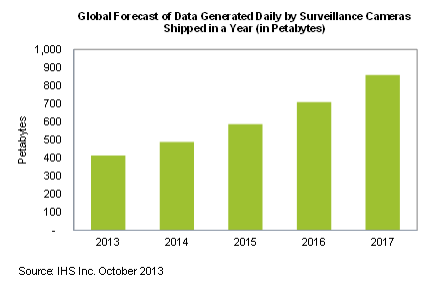
413PB/Day Produced WW By Video Surveillance Cameras In 2013 says IHS
Big Data: The Rise of HD Video Surveillance Cameras Spurs Information Explosion
How much data is in 413 Petabytes (PB)?
● It’s enough to fill 92.1 million single-sided, single-layer DVDs.
● Or, it’s four times the amount of photo and video data stored on Facebook as of February 2012.
● Astonishingly, it is also equal to the information produced in just one day by all the new video surveillance cameras installed worldwide in 2013.
The extraordinary deluge of data in the surveillance business is being triggered by a flood of new high-definition (HD) video cameras entering the market, according to the new report entitled “Enterprise and IP Storage used for Video Surveillance” from IHS Inc. (NYSE: IHS). With shipments of such cameras continuing to rise, the daily data dump is expected to more than double in just four years, expanding to 859 PB in 2017. The overwhelming quantity of information will promote the use of technologies that are designed to handle and process big data in the surveillance market, IHS predicts.
“HD-compliant products are set to account for an increasing share of video surveillance camera shipments during the next four years,” said Sam Grinter, senior surveillance analyst at IHS. “These cameras are gaining acceptance because the quality of their video can be superior to standard-resolution products that formerly dominated the market. But because each HD camera produces far more data than each standard-definition camera, the quantity of data generated by the surveillance market is growing to massive proportions.”
Dealing with Big Data
The surveillance business is adopting several technologies designed to accommodate and mitigate the rising tide of data.
For one, new data compression algorithms should help cut down on the quantity of data. For example, the High Efficiency Video Coding (HEVC) standard—also known as H.265—has been claimed to double the data compression ratio when compared to H.264, which should reduce the amount of data produced per camera in the coming years.
Another promising development is video content analysis (VCA). VCA can be used to reduce the amount of time a video surveillance camera is recording by using virtual tripwires and no-entry zones. Virtual tripwires and no-entry zones can trigger a camera to record once a predefined event has occurred, such as a person entering a parking lot.
This means than only important events will be recorded by video surveillance cameras, rather than simply recording continuously. As deployments of VCA increase, the technology has the potential to reduce the amount of data produced per camera.
The final area of innovation is in hard disk drives (HDDs), where capacities are increasing. While the amount of data produced per camera is expanding, so is capacity to record that data—either on site or via networked systems.

